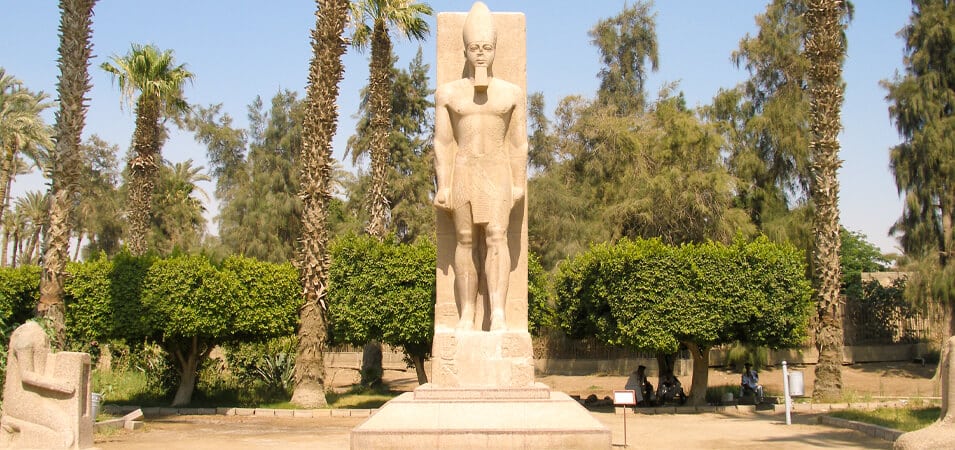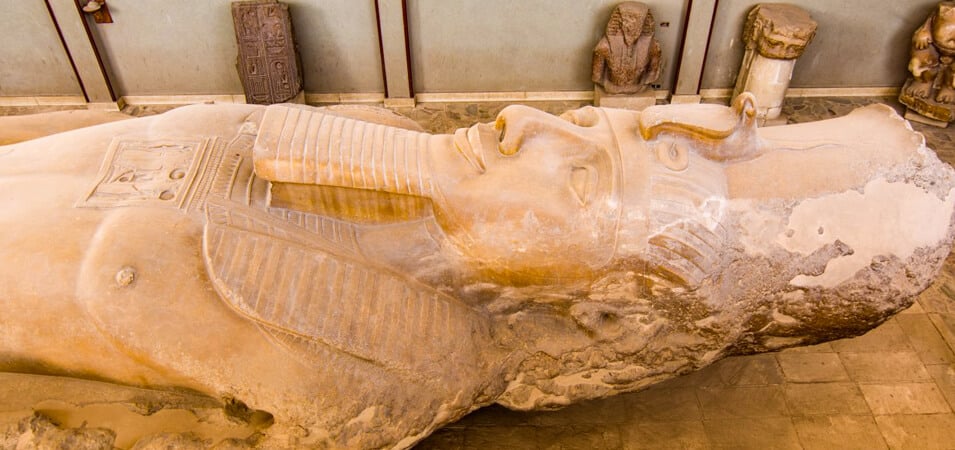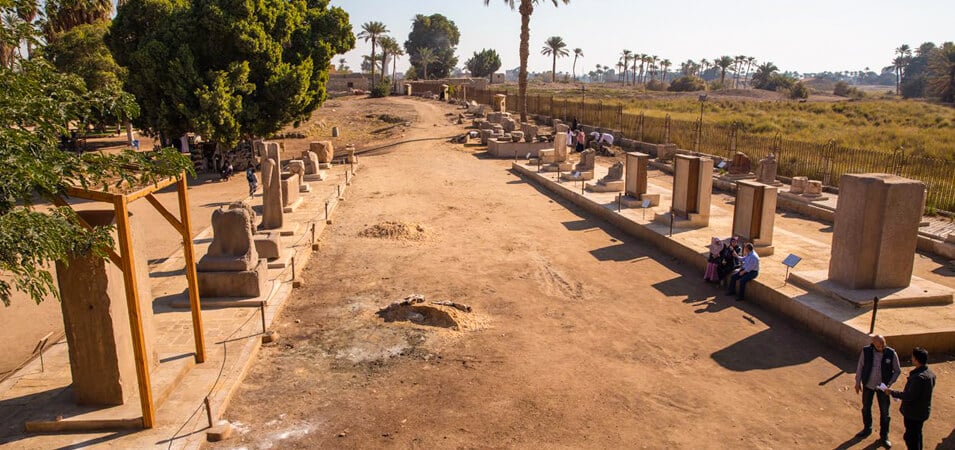Nestled on the banks of the majestic Nile River, the Memphis Necropolis is a testament to ancient Egypt’s grandeur and mystique. This vast funerary complex, located near the modern city of Cairo, is a haunting reminder of the reverence and elaborate burial practices of the pharaohs and nobility. Join us on an enchanting journey as we unravel the mysteries and delve into the significance of the Memphis Necropolis.
Don’t Miss To Check Out Our Egypt Travel Packages
The History and Significance of the Memphis Necropolis

The Ancient City of Memphis: Once the capital of ancient Egypt, Memphis was a thriving metropolis and the seat of power for numerous pharaohs. The Memphis Necropolis was the final resting place for these rulers and the elite, reflecting the city’s importance in life and death.
Funerary Practices in Ancient Egypt: Ancient Egyptians held strong beliefs about the afterlife and invested considerable resources in ensuring a proper burial for their departed loved ones. Elaborate funerary rituals and structures were designed to facilitate the deceased’s journey to the realm of the gods.
The Importance of the Memphis Necropolis: The Memphis Necropolis played a vital role in ancient Egyptian religious and cultural practices. It served as a sacred space where the living could connect with the spirits of the deceased and pay homage to their ancestors. The cemetery also symbolized the eternal power and divine authority of the pharaohs.
The Architectural Marvels of the Necropolis
The Pyramids of Saqqara: Saqqara, located within the Memphis Necropolis, is home to the iconic Step Pyramid of Djoser—a revolutionary architectural masterpiece that marked the transition from mastaba tombs to pyramid structures. This ancient marvel continues to awe visitors with its impressive design and historical significance.
The Mastabas of Giza: Besides the famous pyramids, the Memphis Necropolis boasts a collection of mastabas—rectangular tombs—located in the Giza region. These mastabas are a testament to the ancient Egyptians’ skilled craftsmanship and artistic expression.
The Sphinx and its Enigmatic Presence: No visit to the Memphis Necropolis is complete without encountering the enigmatic Sphinx. This colossal statue, with a lion’s body and a pharaoh’s face, symbolizes power and mystery. The Sphinx has captivated visitors for centuries and continues to spark intrigue and speculation.
Exploring the Tombs and Burial Chambers

The Tomb of Pharaoh Djoser: The Tomb of Pharaoh Djoser, within the Saqqara complex, showcases the grandeur and architectural innovation of ancient Egyptian burial structures. It’s labyrinthine passages and intricate carvings glimpse the beliefs and rituals associated with the pharaoh’s journey to the afterlife.
The Serapeum and its Sacred Bulls: The Serapeum, an underground complex within the Memphis Necropolis, was the final resting place for the sacred Apis bulls—a symbol of fertility and strength. These bulls were mummified and entombed with reverence, reflecting their deep religious significance.
Royal Tombs and Mortuary Temples: The Memphis Necropolis is dotted with royal tombs and mortuary temples dedicated to various pharaohs. These majestic structures were constructed to honor and perpetuate the legacy of the rulers, providing a glimpse into their lives, accomplishments, and aspirations.
Rituals and Beliefs Surrounding Death
The Journey to the Afterlife: Ancient Egyptians believed in a complex journey to the afterlife involving judgment, purification, and eventual union with the gods. Funerary practices and rituals were designed to assist the deceased on this transformative voyage.
Funerary Offerings and Rites: To ensure the comfort and sustenance of the departed in the afterlife, elaborate offerings of food, drink, and personal belongings were placed in the tombs. These offerings represented a continuation of the earthly existence and provided essential provisions for the journey ahead.
The Role of the Book of the Dead: The Book of the Dead, a collection of religious texts, spells, and illustrations, played a significant role in ancient Egyptian funerary practices. It served as a guidebook to help the deceased navigate the afterlife and overcome various challenges encountered along the way.
Conservation and Preservation Efforts

Challenges in Preserving the Memphis Necropolis: Preserving the Memphis Necropolis presents numerous challenges, including environmental factors, urban encroachment, and the need for delicate restoration work. Maintaining conservation and accessibility is crucial to safeguarding this ancient treasure.
Restoration Projects and Site Management: Dedicated conservationists and archaeologists undertake restoration projects to preserve the structural integrity of the cemetery. These endeavors involve meticulous research, delicate conservation techniques, and sustainable site management practices.
Balancing Tourism and Cultural Heritage: The Memphis Necropolis attracts visitors worldwide, eager to witness the splendor of ancient Egypt. Ensuring responsible tourism practices, such as controlled visitor numbers, respectful behavior, and educational programs, is essential to protect the fragile heritage of the cemetery.
Memphis Necropolis: A Gateway to the Past
Visitor Experience and Exploration: Exploring the Memphis Necropolis offers a mesmerizing experience, transporting visitors back to the ancient world of pharaohs and gods. Guided tours, informative exhibitions, and immersive experiences let visitors appreciate the cemetery’s historical, cultural, and spiritual significance.
Educational and Research Opportunities: The Memphis Necropolis is a valuable resource for scholars, archaeologists, and researchers seeking to unravel the mysteries of ancient Egypt. Ongoing excavations, scientific analysis, and interdisciplinary studies shed light on various aspects of Egyptian civilization and burial practices.
The Cultural Significance of the Necropolis: Beyond its historical and archaeological value, the Memphis Necropolis holds immense cultural significance for Egypt and the world. It stands as a symbol of Egypt’s rich heritage, fostering a sense of national pride and promoting cultural exchange and understanding.
Conclusion
The Memphis Necropolis, with its awe-inspiring architecture, intricate burial chambers, and profound spiritual beliefs, provides a captivating window into the ancient Egyptian civilization. As we wander through this sacred city of the dead, we face the timeless legacy of the pharaohs and gain a deeper appreciation for the customs, beliefs, and artistry of one of the world’s most fascinating civilizations.
Don’t Miss To Read Out Our Related Article:
